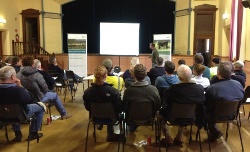1. News:
Feed demand calculator video tutorials
New video tutorials have been released to accompany the updated Feed Demand Calculator. The four tutorials cover how and when to use the tool, how to interpret the results, how to use the "scenario player" functionality to plan ahead and what it all has to do with climate variability. Clicking this link will take you to the tutorials on the MLA website.
Wether trial analysis
The relative performance of many commonly used merino bloodlines has been updated with the 2014 analysis of 22 wether trials and one ewe productivity trial conducted in NSW (17), Victoria (4), WA (1), and Tasmania (1) between 2004 and 2014. The analysis was funded by AWI and NSW DPI and has been published as a NSW Primary Industries Prime Fact (download here), with Dr Sue Hatcher as the lead author. Among other things, the publication shows how commercial producers can choose a finer bloodline that will reduce fibre diameter without compromising fleece weight or how a bloodline with heavier fleece weight can be chosen while maintaining fibre diameter at the current level.
2. R & D Update:
Business shock absorbers can assist with managing climate variability
Managing a variable climate is a fundamental component of Australian Agriculture. A review of historical rainfall and temperature data will quickly demonstrate the climatic variability that Australian farmers work with. Agribusiness consultant Simon Vogt, from Rural Directions, recently investigated the shock absorbers producers can build into their businesses to help cope with climatic variability. Simon's work helped inform the More Lambs More Often project, which is funded by the Australian Government's Carbon Farming Initatitive (CFI) and is being delivered by Rural Industries Skills Development (RIST). Click to download the article.
3. Management Tips:
Using partial records to identify older ewes to retain in the breeding flock
Variation exits between ewes over their lifetime in net reproduction rate (NRR). Retaining the top 50% of older ewes for 1 - 2 additional lambings, combined with early culling of the poorest performing ewes can significantly lift overall flock NRR. Combined NRR at 2 & 3 years of age can reliably predict a ewe’s performance at later ages. By combining pregnancy scanning data with udder examination and using this information to retain better preforming ewes, the overall NRR of the flock can be increased. To download a conference poster on the method for this click here. For a fact sheet on udder assessment click here.
ParaBoss
For any sheep producers that aren't already aware, ParaBoss is a suite of three products for the management of blowflies, worms and lice. The WormBoss, FlyBoss and LiceBoss websites are sources of detailed management information and regional programs that will assist in managing the major parasite risks for sheep. They have been developed by expert panels of parasitologists and veterinarians from across Australia. You can subscribe to a monthly email newsletter with regional updates and feature articles at ParaBoss.com.au
4. Coming Events
|
Over 50 producers recently attended two information sessions in Tasmania called “Maximising Red Meat Returns”. The events highlighted the large range in financial performance achieved by producers and focused on opportunities for improving profitability through learning better skills in pasture and business management. The workshops were presented by Basil Doonan, a consultant from Macquarie Franklin and Simon Foster, a leading producer from the northern midlands. Follow up training activities related to these opportunities will commence in Tasmania in February 2015. Other states are also designing events for sheep producers for early next year. Sheep producers wanting to be involved should contact their MMFS State Coordinator.
|
 |
|
